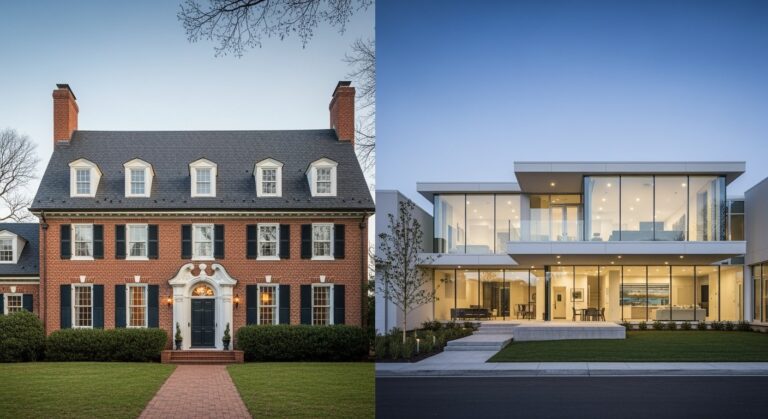Some houses just get it right.
You know the ones. They have a kind of quiet confidence.
They don’t shout for attention, but you can’t help but look.
It’s not about being old or new. It’s something else.
A feeling of permanence. Of being exactly where it’s supposed to be.
The Comfort of the Classic
Traditional homes have a built-in advantage.
They tap into a collective memory of what “house” is supposed to look like.
Think of a classic Colonial or a cozy Cape Cod.
They have pitched roofs that suggest shelter. Symmetrical windows that feel balanced and calm. A central door that says, “Welcome.”
These are shapes we understand intuitively.
And the materials play a huge part.
Brick, stone, real wood siding. These things have gravity. They have texture.
They also age gracefully. Brick develops a soft patina. Cedar shingles weather to a perfect silvery gray. The house doesn’t just get older; it gains character. It starts to tell a story.
There’s a reason these styles have stuck around. A well-built traditional home is rooted in history.
It feels solid. Dependable.
Looks great. Feels right.
Modernism’s Clean Slate
Then there’s modern architecture.
It’s not about looking back. It’s about looking forward.
Or at least, it was. Modernism wanted to strip away all the fussy, unnecessary details of the past. No more decorative trim, no more complicated rooflines.
The idea was honesty.
Let the structure be the star. Let the materials speak for themselves.
So you get clean lines. Flat or low-slope roofs. Huge panes of glass that blur the line between inside and out.
It’s a different kind of beauty.
It’s bold and uncluttered.
A desert-modern home with long, horizontal lines feels like a natural extension of the horizon. A mid-century modern gem with its clerestory windows and simple post-and-beam structure is all about light and air.
It’s clean. It’s functional. And when it’s done well, it’s stunning.
The focus is on the purity of the form itself.
Not a lot of extra noise.
When Good Styles Go Bad
Of course, neither style is foolproof.
We’ve all seen traditional architecture go horribly wrong.
It happens when the rules of proportion and scale are ignored. The result is the dreaded “McMansion.” Too many gables fighting for attention. A jumble of materials that don’t belong together. Stone veneer next to vinyl siding next to stucco.
It’s a caricature of a traditional home.
It has all the parts, but none of the soul. It feels inauthentic because it is.
But modern homes can miss the mark, too.
A design that felt cutting-edge in 2005 can look incredibly dated today. That stark white box can quickly feel cold and sterile, more like a dental office than a home.
Without the warmth of natural materials or a connection to its site, a modern house can feel alien. Imposing.
It lacks a certain human touch.
It doesn’t invite you in.
Finding That Timeless Quality
So what’s the secret? What gives a home that lasting, timeless appeal?
It’s not really about choosing a side in the modern vs. traditional debate.
It’s about sticking to a few core principles that work for both.
It’s All About Proportion
This is the big one. A timeless home just feels right-sized.
The windows are in harmony with the walls. The front door feels significant but not overwhelming. The overall mass of the house feels balanced.
A perfectly proportioned modern cube can have the same satisfying sense of order as a classic Georgian manor.
It’s a subtle thing. But when it’s off, you feel it. The whole composition seems a bit awkward.
Honest Materials Matter
Timeless homes are built with materials that are true to themselves and age well.
Whether it’s the rugged stone on a traditional farmhouse or the beautiful cedar siding on a modern cabin.
These materials develop character over time. They don’t try to be something they’re not. Think board and batten siding, standing seam metal roofs, or smooth, architectural concrete.
They have texture. They have integrity.
They feel real. And that feeling doesn’t go out of style.
A Connection to Place
A house that ignores its surroundings will always feel a little lost.
Timeless homes feel like they belong to their landscape.
A home in the mountains might use heavy timbers and stone, echoing the rugged terrain.1 A coastal home might have wide porches and big windows to capture sea breezes and views.
The colors, the materials, the very shape of the house should feel connected to its environment.
It makes the design feel intentional. Inevitable, even.
Simplicity Wins
Look closely at the homes you admire most.
Chances are, they have a certain simplicity to them.
This doesn’t mean boring. It means they have a clear, strong concept. They aren’t cluttered with too many ideas.
Maybe it’s a simple, classic gabled form. Or maybe it’s a clean composition of intersecting rectangular volumes.
There’s a confidence in not trying to do too much.
The design is edited down to its beautiful, essential elements.
It’s a quiet approach. And quiet lasts.
Ultimately, that timeless feeling is hard to pin down with a single label.
It’s not just “modern” or “traditional.”
It’s a blend of balance, quality, and a deep sense of place.
It’s the kind of design that feels both of its time and like it could have existed forever.
And that’s a goal worth striving for.

